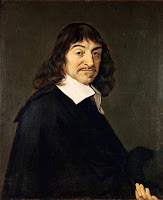We concluded the last post on a note of uncertainty, not to say bewilderment, as physics seemed to have been reduced to “a mystic chant over an unintelligible universe.” Smith now proceeds to analyse the possible cause of this unintelligibility by taking us into the domain of philosophy.
To resolve the perceived problems, it is true that quantum theorists had called into question a number of fundamental assumptions, even the principles of logic. With remarkable acuity, Smith identifies a major philosophic postulate that has been missed altogether by the theorists or observed but dismissed as unchallengeable.
 |
| René Descartes. |
(the) splitting of the real into two mutually exclusive compartments: an external world comprised of so-called res extensae or “extended entities,” and an internal and subjective domain consisting of res cogitantes or “thinking entities.”
After Frans Hals [Public domain] circa 1649-1700. Louvre Museum.
Smith prays in aid Whitehead and Heisenberg as he makes the bold assertion that it is this very Cartesian partition that accounts for the fact that no-one understands quantum theory. Having noted that the Cartesian view has a stranglehold within the scientific community, he goes on to compare it to Democritean atomism which shares the notion that “by convention there exist colour, the sweet, and the bitter, but in reality only atoms and the void”. The key issue, it would seem, is to understand how the physicist's sense perception can transcend the subjective realm of res cogitantes so as to perceive not a mere image but the object itself, the world of res extensae. He claims that, philosophical considerations aside, James Gibson has produced an “ecological theory of visual perception” which falsifies the Cartesian premise on scientific grounds. This will be elaborated in a later chapter.
Smith now poses a significant question: if we can perceive the external world (eg, the red apple in my hand), is it possible to interpret physics in non-bifurcationist terms? His answer is in the affirmative and he introduces an important ontological distinction at the outset of his reasoning: objects are either corporeal or physical. The distinction is ontological because it results from two fundamentally different ways of knowing:
- direct perception
- measurement (or mensuration), the modus operandi of physics.
- the corporeal, accessed by sense perception; and
- the physical, accessed through the discoveries of physics.
To be continued.
[1] René Descartes: (1596 – 1650) was a French philosopher, mathematician, and scientist.
No comments:
Post a Comment